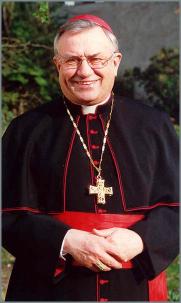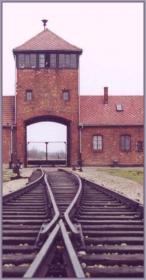German churches profited from slave labour during Nazi era
Both German state churches are now known to have used slave labour during World War II, but only the Catholic Church refused to join the national compensation fund. Documents imply that the churches' slave labourers were sent to death camps when they were no longer useful and that the churches knew about the death camps for the babies of the East European workers, yet said nothing.
For 55 years the Catholic and Protestant (EKD) churches in Germany “forgot” that they'd used slave labourers during World War II. However, in August 2000, after some survivors living in the US began suing German companies, a foundation was set up to grant payments to claimants if they’d renounce their right to any further legal action. The foundation was financed by equal contributions from the German Government and a group of German firms, for a total of 10 billion Deutschmarks. [1] That autumn the Protestant Church (EKD) joined with a contribution of 10 million Marks. [2]
 But not the Catholic Church. The head of the Bishops Conference, Karl Lehmann, (who was made a cardinal the next year), said that all this had nothing to do with his church because it had never used forced labour.
But not the Catholic Church. The head of the Bishops Conference, Karl Lehmann, (who was made a cardinal the next year), said that all this had nothing to do with his church because it had never used forced labour.
It was not going to contribute to the fund of the German companies. The Foundation had not the slightest relevance to the situation of the foreign workers in Catholic institutions, according to Bishop Lehmann. In the proposal for the Foundation it was stated that “Slave labour and forced labour meant not only the denial of fair wages. They meant abduction, denial of rights, the brutal disregard of human dignity”. Research in the Catholic area had shown, however, that forced labourers there were “in most cases paid according to the official wage scale” [i.e. the paper regulations of the Nazis], they received bed and board [which was deducted from their paper “wages”, despite the fact that His Excellency implies otherwise] and they were even given pastoral care. “Cases of exploitation or forced performance of heavy labour or brutally hard work have so far not been proven.” [3]
The German Catholic Church “investigates” its own use of slave labour
Actually, there is quite a bit of proof, as is made clear below, but denying this allowed the Bishop to keep it an internal matter. The Church would take care of everything quietly through its own social agencies in Eastern Europe, in other words, faith-based compensation for Church slave labourers.
Prominent German Catholics criticised the decision of their church not to join German industry and the Protestant (EKD) Church in the common compensation fund.
Otto Graf Lambsdorff [FDP] said that the Catholic Church must follow the example of the Protestant Church and also contribute to the compensation funds.
The vice-president of the [Christian] Union fraction, Wolfgang Bosbach, (CDU) said: “Whoever employed forced labour in the Nazi period must today pay into the funds with no ifs and buts”.
Lambsdorff criticised [his own church]: “In contrast to the Protestants the Catholic Church has always offered the excuse that it must first do research into where it had employed forced labour. In the beginning it [even] said there hadn’t been any.” [4]
However, the Church continued to maintain that the matter required deep archival study. Finally on 8 April 2008 Bishop Lehmann announced that the Church had completed its official investigation of itself.
The 703-page report claims that records only survive for 5904 of the mostly East Europeans who were forced to work as gardeners, hospital orderlies and grave diggers in Church institutions. At the news conference Bishop Lehmann repeated his assertion that there was no proof that any of them had to do “hard labour”. [5] This raises questions about his new report, for there’s well-publicised documentary evidence to the contrary.
 Broken and sent “away”
Broken and sent “away”
At the Jerusalem Graveyard in Berlin-Neukölln 26 Protestant and two Catholic dioceses together ran a camp in which were billeted about 100 “East[European] workers”, whose task was to bury bomb casualties. From a contemporary report on the church camp, comes this entry for 19 March 1945.
“The five East(ern European) workers listed below are, on account of their physical condition no longer suitable for the work to be done at graveyards”. They have broken bones, general weakness, congestive heart failure. “We therefore request the named persons to be assigned to an appropriate collection point, as they are just lying in the camp and taking up the places for men capable of work.” The camp director, Gustav Wenger, closes with the greeting “Heil Hitler”.
Those rejected as unfit in this way were usually sent to the death camp – “an appropriate collection point”. [6]
According to the Church report issued on 8 April 2008, the Catholic Church had employed at least 5904 slave labourers in 776 Catholic institutions — and they admit it could be more. However, it has managed to minimise the consequences, in terms of both public opinion and financial compensation. Holding itself aloof from the common fund has allowed the Catholic Church to treat the compensation of its victims as a purely internal matter, with no oversight and out of the public view. The report claims that by the end of 2004 it had paid each claimant 2556 Euros (at that time worth about $3776). However, almost 60 years after the war's end the Church was only able to find 587 of these aged survivors. The delay caused by the remarkable forgetfulness of the German churches has saved them much unnecessary bother and expense. [7]
At the death camp for babies, baptisms but no church protests
Labelled “foreign”, “racially inferior” and “impeding the use of labour” the children of Polish and Soviet female forced labourers died in barracks, sheds and stalls. For these “collection points” Himmler chose the nice official name “Care Homes for Foreign Children”. Between 1943 and 1945 in the Braunscheig region alone at least 800 infants died, most of them only a few weeks old. [8]
Shocking picture: In the winter of 1943/44 the SS had photos taken in the babies’ death camp in Braunschweig, among them this photo of a wizened, dying infant.
The state churches apparently did more than profit from Hitler’s slaves. There are indications that they also kept quiet about the murder of their children. […]
Pastors such as Hartwig Hohnsbein from Göttingen, who has spent a long time closely examining the role of the official churches in the Nazi period, are convinced that they were deeply involved. Despite knowing of it, the churches kept silent about the killing of the babies of the female forced labourers.
According to an order from the summer of 1943 for the “Treatment of pregnant foreign workers and the children of foreign workers born in the Reich”, says Hohnsbein, for example in the district of Braunschweig/Wolfsburg/Gifhorn about 1000 infants of “East [European] workers” perished. Classified as “racially inferior”, they died in hut camps, separated from their mothers and systematically starved. […]
For his suspicion that the killing of the children was “sufficiently well known in the diocese” he can offer evidence. In Rühen, [a small village] in the rural district [Kreis] of Gifhorn, babies were "hastily buried in the churchyard in mass graves”. [9]
The babies were only nursed for eight days and on the ninth their mothers were sent back to work. [10] Few were ever seen again.
In a so-called “Maternity Home for East [European] Workers” between 1943 and 1945 at least 365 infants, the children of Polish and Soviet forced labourers lost their lives. Most of them died shortly after the enforced separation from their mothers at the age of two or three weeks. The catastrophic hygienic conditions, neglect and insufficient food were methodically applied. The newborns had to die because the Nazis considered their existence to be racially inferior and economically worthless. […]
The dead Polish children were buried hastily without the presence of their mothers in the old Catholic graveyard on the main street, the children of Soviet mothers burnt in the crematorium. The Catholic priests conducting baptisms in the maternity barracks, who had seen the already rotting naked corpses in cardboard cartons in the graveyard chapel, kept silent and after the war exonerated those who had been jointly responsible; in Velpke, in the district of Helmstedt, where similarly gruesome things happened, the Protestant pastor declared it had not been his “responsibility”. [11]
Notes
1. “Stiftung 'Erinnerung, Verantwortung und Zukunft' ”, Wikipedia. http://de.wikipedia.org/wiki/Bundesstiftung_%22Erinnerung%2C_Verantwortung_und_Zukunft%22
2. Press release of the EKD, 19 January 2004. http://www.ekd.de/aktuell_presse/pm7_2004_ekhn_ekkw_zwangsarbeiter.html.
3. Frankfurter Rundschau, 30 September 2000, cited in the Hessian Radio Listeners' Information, 31 October 2000. http://www.humanist.de/kultur/tips001029.html
4. “Lambsdorff attacks the Catholic Church: it should pay into the fund for forced labourers and not always 'make excuses'”, (“Lambsdorff greift katholische Kirche an: Sie soll in den Zwangsarbeiter-Fonds einzahlen und sich nicht 'immer herausreden' ”), Hamburger Abendblatt, 24 July 2000. http://www.plbg.de/lexikon/ostarbeiter/stuttgart1.htm
5. Gernot Facius, “Zwangsarbeit im Auftrag der katholischen Kirche”, Die Welt, 8 April 2008. http://www.welt.de/politik/article1881490/Zwangsarbeit_im_Auftrag_der_katholischen_Kirche.html
6. Süddeutsche Zeitung, 14 July 2000, cited in the Hessian Radio Listeners' Information, 31 October 2000. http://www.humanist.de/kultur/tips001029.html
7. “Catholics used forced labor in Nazi era:
Nearly 6,000 workers exploited during World War II, new church report says”, Reuters, 8 April 2008. http://www.msnbc.msn.com/id/24012634/
8 . From the Introduction of: Andreas Frewer and Günther Siedbürger, eds., Medizin und Zwangsarbeit im Nationalsozialismus. Einsatz und Behandlung von „Ausländern“ im Gesundheitswesen, Frankfurt am Main / New York 2004. http://www.birdstage.net/texte09.html
9. Wolfgang Bayer and Peter Wensierski, “Forced labour: In the service of the Lord”, Der Spiegel, 31 May 2000. http://www.kloster-ettal.de/dokumentation/20000731spiegel.htm
10. Bernhild Vögel, “Entbindungsheim für Ostarbeiterinnen” Braunschweig, Broitzemer Straße 200,
Hamburger Stiftung für Sozialgeschichte des 20. Jahrhunderts, Hamburg, 1989, p. 35. http://www.birdstage.net/images/entbindungsheim.pdf
11. Bernhild Vögel, “Gott dem Herrn Dank sagen: Festschrift für Gerhard Heintze”, 18 November 2002. http://bs.cyty.com/kirche-von-unten/archiv/gesch/fs90heintze/Voegel-Wie-es-weiterging.htm







 The Nazis and the German churches
The Nazis and the German churches